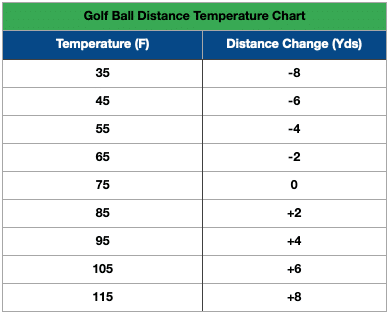It’s very likely you’ve heard cold weather affects your golf ball distance, but how much? And why?
The overall effect of temperature depends on the club. For every 10 degrees, you will gain or lose about 2 yards of distance. This is largely believed to be due to air density.
But what about the ball itself? What performance differences occur at varying temperatures?
I decided to put this to the test. I took a dozen new Vice Pro golf balls dividing them into 4 different temperature zones, then tested them on a high-end launch monitor to see how each would perform. I was pretty surprised with the results.
Why Temperature Changes Affect Distance
It really comes down to air density. Cooler air is more dense and creates more drag on the golf ball. As temperatures rise, air density decreases.
This is also why warm air rises. Anyone who has ever been in a two-story house during the summer knows this all too well.
According to Andrew Rice, one of the top golf coaches in the U.S., a good rule of thumb is – for every 10 degrees above or below 75 degrees, you will gain/lose 2 yards of carry distance for each club in your bag (source).
75 degrees is the reference point because Andrew believes most golfers get to know their club distances at an average temperature of 75.
With every decrease of 10º below 75º, each club in your bag will carry (roughly) 2 yards less.
With every increase of 10º above 75º, each club in your bag will carry (roughly) 2 yards more.
Golf Ball Distance Temperature Chart

On a hot day, you can see the golf ball travels a bit further. If you are playing winter golf, the cold weather definitely has an affect on the golf ball, causing you to lose distance due to the dense cold air.
If you are a fair weather golfer, like I am, you really don’t need to worry about the affects of temperature changes too much. A couple of yards here and there is all.
Physics of Golf Ball Distance
Golf ball distance starts with clubhead speed, and how efficiently you strike the ball. Efficiency is commonly referred to as Smash Factor. It is a simple math formula dividing ball speed by club head speed.
Two other key factors in golf ball distance are trajectory and spin. Especially with longer clubs such as your driver.
To maximize distance, a higher trajectory and lower spin is necessary. But optimal numbers depend on your swing speed and subsequent ball speed. Here is a detailed chart outlining optimal launch and spin numbers.
There is one more important factor – the golf ball itself! Not all golf balls are created equal. There are absolutely differences in performance, including distance, across different balls at varying swing speeds. Click here to find the longest golf ball for your individual swing speed!
Once you have selected the best golf ball for distance based on your individual swing speed, and optimized your launch angle and efficiency, the rest is simply left to nature. Wind, air density, rain, temperature, and elevation.
How Does the Temperature of the Golf Ball Itself Affect Distance?
Based on a personal study conducted, the effects of temperature on golf ball distance were examined by subjecting four groups of golf balls to different temperature conditions.
One group was left in the freezer for about 48 hours, another in the refrigerator, another at room temperature, and heating the fourth group to approximately 120 degrees.
Subsequently, all four groups were tested on the launch monitor using a driver to determine if any noticeable differences in overall distance occurred. I was able to get good data from all 4 groups at 109mph swing speed.
Surprisingly, the findings of the study revealed that there was no significant change in distance observed among any of the four groups.
Despite the varying temperatures to which the golf balls were exposed, the results remained consistent, suggesting that temperature did not have a noticeable impact on the distance the balls traveled.
These findings may come as a surprise, they certainly surprised me!
I did notice the frozen balls felt much harder and made a different sound when they were hit. It was actually a bit worrisome, I cringed as I looked at my club face, fearing it was broken. Nonetheless, I was able to get the frozen balls, refrigerated balls, and heated balls, all to travel about the exact same distance – 305 yards from a 109 swing speed hit.
Final Thoughts
The atmospheric temperature will affect golf ball distance by about 2 yards for every 10 degrees of temperature change starting at 75 degrees. Cooler temperatures will cause the ball to travel shorter, warmer temperatures will allow the ball to go further.
This is due to air density! Not the actual temperature.
The ball itself has no noticeable impact on overall distance. So leaving your bag in the trunk of your car is really not going to help. Although the frozen ball in my small experiment didn’t change things much, I would not recommend it, simply to save your club!
Good luck on the golf course!
